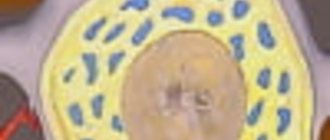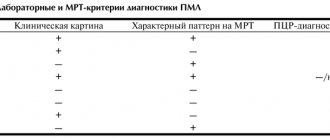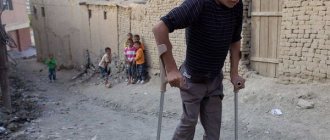Acalculia is a neuropsychiatric syndrome characterized by loss of the ability to perform arithmetic operations and perceive numbers. Develops when the dominant hemisphere is damaged: in right-handed people, the left hemisphere, in left-handed people, the right hemisphere.
Acalculia is an acquired disease and occurs against the background of damage to areas of the brain or neuropsychiatric diseases. It occurs against the background of disturbances in the temporal, parietal and occipital regions of the cerebral cortex, which in turn arises due to injuries, neuroinfections, neoplasms, etc.
Acalculia also often develops against the background of an underlying neurological or mental illness. Thus, acalculia is often combined with the following diseases: optical agnosia, alexia, dyslexia, acoustic-mnestic aphasia, attention deficit, sensory aphasia, amnesia, dementia, stroke.
Reasons for violation
Acalculia occurs due to damage to the parietal, occipital, temporal and prefrontal parts of the cerebral cortex. The causes of such brain damage can be different:
- a significant number of neurological disorders in the perinatal period
- hereditary factor;
- organic brain lesions;
- neuroinfections;
- neoplasms in the brain;
- various intoxications;
- dysmetabolic abnormalities;
- brain damage due to infectious diseases;
- negative social environment;
- cerebrovascular diseases;
- traumatic brain injuries.
Classification
Acalculia, as a term, was discovered in 1919 by F. Henschen. Research activities on violations of the synthesis and analysis of computational operations have made it possible to distinguish two types of pathology - primary and secondary.
- Primary acalculia is the result of disturbances in the temporal, occipital and parietal cortex. The key feature is a violation of the synthesis and analysis of spatial representations. The patient has difficulty performing computational processes and distinguishing numbers. In the vast majority of cases, the patient does not understand the difference between concepts such as front and back, down and up, right and left.
- Secondary acalculia is the result of existing syndromes of a neuropsychological nature.
Types and forms of the disease
The development of acalculia occurs with disorders of various cognitive systems. Depending on which cognitive function is affected, the following types of disease are distinguished:
- Verbal – deviations in the verbal designation of mathematical concepts. The patient can successfully perform mathematical operations, but cannot verbally indicate the names of numbers, symbols, and is unable to indicate the number of objects.
- Apraxic – a person is unable to count objects. The patient cannot count objects and identify their quantitative characteristics.
- Dyslexic – lack of ability to read mathematical symbols and express quantitative terms.
- Graphic – the inability to write down mathematical symbols and signs, as well as to correctly depict geometric figures.
- Operational – loss of ability to perform mathematical operations.
Also, cases of acalculia can be divided on the basis of primary and secondary.
Primary (specific) – caused by lesions of areas of the cerebral cortex, the following types are distinguished:
- Frontal - caused by dysfunction of the frontal lobe of the brain, which is responsible for the control and regulation of all human mental functions. The ability to count is impaired due to deviations in the organization of conscious activity.
- Parietal (parieto-occipital) - occurs when the parieto-occipital areas of the brain are damaged. The patient’s concept of “number”, understanding of the essence of counting operations, and perception of spatial coordinates are impaired.
Secondary (nonspecific) – occurs due to a neuropsychiatric disease, the following types are distinguished:
- Optical - occurs with pathologies of the lobes of the brain responsible for the visual analyzer. With optical acalculia, the visual perception of numbers and mathematical symbols is impaired. The patient is unable to distinguish between similar arithmetic symbols and recognize Roman numerals.
- Sensory – develops with damage to areas of the brain involved in the acoustic perception of speech. Manifests itself in difficulties with oral counting and carrying out counting operations by ear.
- Acoustic-mnemonic – also associated with the acoustic perception of speech. The difference is that the patient has impaired auditory-verbal memory and a reduced volume of auditory perception.
Difference from dyscalculia
Acalculia and dyscalculia are similar concepts, but there are differences between them. It lies in the fact that dyscalculia is a consequence of congenital disorders of brain development and with it mathematical knowledge is not fully absorbed. Acalculia is an acquired condition, and occurs due to neurological injuries and disorders acquired during life.
Acalculia in children
The dysfunction in question is an acquired ailment, manifested in a failure to perform arithmetic operations.
The causes of acalculia in children are damage to brain structures. The ability to count is a fundamental skill, the absence of which significantly complicates life and interferes with obtaining an education and mastering a profession. The dominant place in the formation of counting processes belongs to the parieto-occipital zones and parietal segments of the cortex.
The causes of acalculia are due to damage to the listed brain areas, resulting in disruptions in spatial orientation and understanding of spatial relationships.
Luria determined that the majority of children suffering from the described defect are proficient in ordinal counting, correlating the number of objects, and can count, but they cannot understand the principle of place value or operate with generalized sets. The cardinal symptoms of this pathology are: a breakdown in the understanding of numbers, a disorder in understanding the bit structure of a number, and an understanding of the meaning of signs. Numeracy is the integration of several cognitive skills. An individual suffering from acalculia experiences great difficulties in four areas.
Acalculia syndrome and its manifestations are determined by the location of the abnormal focus. Thus, if the occipito-parietal segments are damaged or if there is a bilateral lesion, primary acalculia can be assumed. If the occipital segment is damaged, the visual image of the number disappears; for the patient it ceases to be a symbol reflecting a certain quantity. An individual recognizes numbers; they are mixed in perception. This especially applies to numbers that are similar in style. If the temporal zones are damaged, failures in mental counting are observed, and in the prefrontal segments, purposeful activity is disrupted, the patient cannot plan counting actions and control their implementation.
Sometimes the dysfunction in question does not completely deprive the child of the ability to perform computational operations. Some young patients retain their addition skills, but subtraction becomes an impossible task for them. The described illness can often be accompanied by sensory aphasia. The degree of impairment in the work of arithmetic operations varies from absolute inability to calculate to errors in counting operations and when manipulating numbers.
Symptoms of the disorder
Symptoms of acalculia vary depending on the form of the disease.
In the primary form of the disorder, the patient experiences the following symptoms:
- difficulty understanding the difference between seemingly similar numbers (for example, 147 and 174);
- inability to perceive the category of numerical digits;
- difficulties performing simple arithmetic operations;
- violation of understanding of the concept of “number”;
- lack of ability to compare numerical values;
- the perception of spatial coordinates is impaired;
- difficulties in estimating numbers containing the digit “zero”;
- Difficulty with subtraction, but addition is relatively easy.
The secondary form of acalculia is manifested by the following symptoms:
- there is no visual perception of numbers, and ignorance of their names;
- the perception of numbers and mathematical operations by ear is impaired;
- problems with understanding mathematical operations, planning them and controlling their execution.
Inspection and diagnostics
A defectologist, psychologist, psychiatrist, or specialist in neuropsychology can identify the disease.
Numeracy disorder is rarely the only cognitive disorder and is often accompanied by other pathologies. Acalculia may not be detected during the initial examination and diagnosis due to more intense manifestations of other disorders.
The diagnosis can be made after performing arithmetic tests and analyzing them. Excessively low results indicate pathology. It is also necessary to use such diagnostic measures as tests to identify pathologies of speech, writing, reading, spatial orientation, and praxis.
Pathogenesis
Counting is the most complex function of a person’s GNI. The counting center has a very close connection with many other areas of the cortex. Only the joint participation of these zones makes it possible to perform arithmetic operations. If the functioning of one of the zones is disrupted, problems with the account arise.
Due to disease, injury or congenital defects, neurons undergo degenerative changes and sometimes even die. Acalculia develops when areas of the brain responsible for counting functions are involved in the pathological process. Most often, acalculia is not the only disorder in the patient, since the root causes of its appearance also affect other areas of the brain.
Treatment and correction
When treating acalculia, the main therapeutic measures should be aimed at eliminating the causes of the disease.
The choice of correction program depends on the form of the disease and, accordingly, the causes of its occurrence. Complex therapy is carried out by the following specialists: clinical psychologist, defectologist, psychiatrist, neuropsychology specialist.
Primary violation
In the primary form of acalculia, the main task is to restore the patient’s perception of numbers and their digits. Special techniques are used, the main principle of which is to work with the patient’s visual memory.
Cards with images of numbers, objects and their quantities are used. It is preferable to use bright and varied colors, as this promotes better perception and memory. When working with children, it is advisable to use play forms.
Working with numbers involves the need to decompose any of them into variations. An auxiliary tool can be sticks. For example, the patient is given the number 7 and given the task of breaking it down into its possible components.
The patient performs this task by arranging the sticks in the following combinations: 3+4, 2+5, 1+6. All actions are recorded in a therapy diary. As the result progresses, oral commentary on mathematical operations is added - all operations are accompanied by pronunciation. This helps develop the ability to count mentally.
If the perception of the names of numbers and their digits is impaired, the work of specialists is to pronounce numbers from 1 to 100 together with the patient, and provide parallel explanations regarding units and tens. One of the exercises is to write numbers in numbers under their letter symbols. For example, next to the words two hundred and forty one write 241.
After 3 lessons, oral forms of work and voicing of arithmetic operations should be added to visual and figurative materials.
Therapy for the secondary form
Treatment for the secondary form of acalculia is selected depending on the area of damage to the cerebral cortex:
- When the occipital cortex is damaged, treatment is aimed at restoring the correct spelling of numbers and their visual perception. The following methods are aimed at this: exercises with a motor image of a number, object counting, various manipulations with tasks and numbers, voicing numbers while simultaneously imagining them in the mind. The best results are achieved with a satisfactory level of development of visual memory, imagination, and auditory perception.
- When the temporal areas of the cerebral cortex are damaged, patients have impaired auditory perception of numbers. For this disorder, there is no need for specialized therapy.
- For disorders in the prefrontal cortex, therapeutic measures are aimed at teaching the understanding of numbers and simple arithmetic operations, gradually moving on to more complex operations.
Disease prevention
To overcome acalculia, a neuropsychologist and speech therapist carry out labor-intensive and lengthy work with the patient. The attending physician must cooperate not only directly with the patient, but also with his relatives. The sooner such treatment is started, the better the prognosis for recovery will be, which is determined by the size of the affected area. In addition, a significant role is played by the patient’s age and the degree of speech disorder. It is known that young patients demonstrate better dynamics. In addition, if the disease occurs at a young age, then a severe disturbance in speech development may subsequently occur, since acalculia is often combined with aphasia.
Preventive measures primarily consist of preventing brain injuries and preventing vascular accidents. If tumors are present, they must be identified immediately. Acalculia can be treated if you address this problem in a timely manner without delaying a visit to a specialist.
Implications and Limitations
Acalculia can cause various complications.
Such negative consequences include agrammatism (difficulties in composing and perceiving sentences), paraphasia (replacement of sounds, incorrect use of sounds), speech embolus (obsessive repetition of a word or phrase). The consequences of acalculia also include a decrease in an individual’s social adaptation due to a combination of the disease with other cognitive impairments. As a result, the patient's quality of life decreases.
When the disease develops in children, this causes problems in learning, social adaptation at school, impairs communication skills and can negatively affect the child’s further cognitive development. Children may develop low self-esteem and depression.








